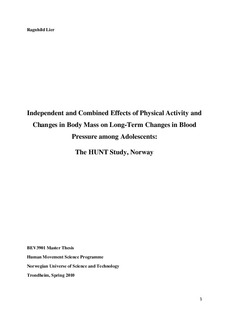| dc.description.abstract | Background: The association between overweight or obesity and blood pressure is well established among adolescents. Also the beneficial effect of physical activity on reduction in body mass is well known. However, studies done on the possible effect of physical activity on blood pressure are limited. Thus, the purpose of this study is to examine the independent and combined effect of baseline physical activity and changes in body mass on change in blood pressure in a population of Norwegian adolescents.
Methods: Weight, height, waist circumference (WC), hip circumference (HC), systolic blood pressure (SBP) and diastolic blood pressure (DBP) were measured, and body mass index (BMI) and waist-hip ratio (WHR) were calculated among 1814 adolescents (777 males and 1037 males) aged 13-19 years, who participated in a population based study in 1995-1997 (Young-HUNT 1), and a follow-up study in 2006-2008 (HUNT 3), in the county of Nord-Trøndelag, Norway. Internationally accepted cut-off points were used to classify the subjects as underweight, normal weight, overweight or obese, and changes between the body mass variables from baseline to follow-up was calculated. The adolescents completed a detailed questionnaire including physical activity and smoking habits. We calculated changes in mean SBP and DBP within categories of changes in body mass and level of physical activity score (PAS) at baseline, and examined the crude and adjusted differences in change in mean SBP and DBP between the categories.
Results: An increase in either of the body mass variables resulted generally in a higher change in mean SBP and DBP among both males and females, compared to those who were stable, whereas there was no evidence of an independent effect of baseline PAS on changes in SBP or DBP. Analysis of the combined effect showed that those who had a stable BMI had approximately similar changes in SBP and DBP, irrespective of their baseline PAS level. Moreover, those who increased their BMI had a higher change in both SBP and DBP than those with a stable BMI, with no evidence of any modifying effect of PAS.
Conclusion: In this population-based study of Norwegian adolescents, we found that an increase in body mass from Young-HUNT 1 to HUNT 3 was associated with a higher change in mean SBP and DBP, compared to those who were stable, but that baseline level of physical activity seemed to have no influence on these associations. Thus, avoiding weight gain seems to be the key factor to prevent unfavorable BP levels. | nb_NO |
